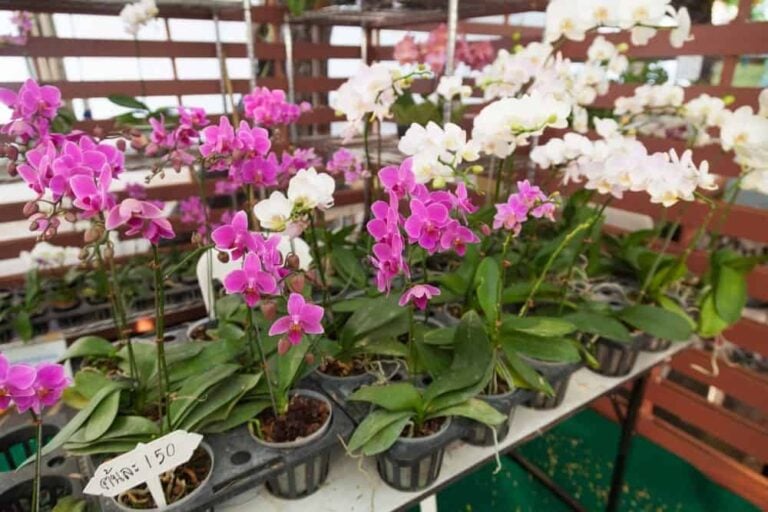Wrap Your Mind Around Our Sansevieria (Snake Plant) Care Tips
A common plant in commercial buildings and office, the Sansevieria plant has long green or green-grey leaves arranged in a rosette around a central growing point. The sturdy, leathery leaves can grow up to four feet tall and provide a focal point in otherwise drab- looking rooms, like boardrooms or hospital corridors. The Sansevieria can survive just about any neglect or punishment, except for over watering, and can easily be propagated in a soil mixture or water, or by dividing a mature plant and repotting it in one or more containers. The Sansevieria is also called the Snake Plant, Mother-in-law’s Tongue or Devil’s Tongue.
Growing and Maintenance of the Sansevieria
The genus Sansevieria consists of 70 species, including the Sansevieria trifasciata. With its thin, dark green leaves, banded yellow on either side, the Sansevieria trifasciata makes an attractive, low-maintenance potted plant for homes and offices. Native to Africa, India, and Indonesia, this sturdy plant forms dense stands spread by creeping rhizome. The vertical leaves grow from a rosette in the center of the plant.
The Sansevieria’s leaves are sword-shaped and can reach 35 inches long and 2.4 inches wide when mature. The Snake Plant graces large planters in hospitals, hotels, stores and banks. This ornamental plant also removes toxins from the air, and they may even provide allergy relief. (source)
The Snake Plant’s leaves may be poisonous if ingested. Keep the plant away from curious pets and avoid placing it in children’s bedrooms.
Watering
This drought-tolerant plant makes an ideal potted plant for the home or office. It requires little watering and rarely needs to be feed or repotted. There’s little danger of damage to the plant if it becomes root bound, and it does well in low humidity.
Allow soil to dry completely between waterings. Water every other week during spring and summer, and test soil before watering in the fall to make sure it’s dry. During the winter, water monthly or only when soil is dry to the touch.
Water only the soil, and be careful not to get any water on the leaves. Pouring water directly on the Snake Plant’s leaves causes them to rot. When leaves become yellow or mushy, it’s usually due to over watering. Always use a well-draining soil, and don’t let the plant sit in water, even for a short period.
Soil and Fertilizer
The Sansevieria will flourish without feeding, but you can use a mild cactus fertilizer during the spring and summer. Avoid feeding the plant in the winter.
Light and Temperature
A Snake Plant tolerates many light conditions, from 60 percent to 80 percent shade to bright light levels. However, the plants grow best in medium light with partial shade.
The Sansevieria trifasciata is sensitive to cold, and shouldn’t be exposed to temperatures below 50 degrees, frost or cold winds. The Snake Plant grows well in temperatures from 70 to 90 degrees.
Learn more about this sturdy plant by watching “Let’s Talk about Snake Plants – Sansevieria” from the PlantzNThings YouTube Video Channel.
Planting and Propagating
Although over watering a snake plant can kill it, rooting it in water is one of the best propagation methods for this plant. Select a healthy leaf on a mature plant and cut it off with sharp shears. Place the cut end of the leaf in a container with enough water to the bottom one-fourth of tissue. Position the container in indirect sunlight. Change the water every few days, and soon you’ll see small roots form. Place the rooted leaf in sand or peat moss and follow the watering and lighting procedures for the Snake Plant.
Propagating a snake plant with cuttings is even easier than growing a root in water. Cut a leaf from a grown plant, and let it dry and callus for a day or two. Fill a container with slightly moist sand and place the cut end into the sand. In a few weeks, a new Sansevieria will sprout.
Potting and Repotting
Divide a grown plant in the spring for best results, though you can repot the Snake Plant any time of year. Remove the plant from its old pot and use a hand saw or shears to cut the base into sections. You may be able to cut it in half unless the plant has too many rhizomes. Place each section in a new container with the fresh potting medium during the repotting process.
Thoroughly water the old plant before removing it to help loosen the root ball. The root ball should slide right out of the pot when you turn it upside down, but you may need to pound on the sides to loosen it. If there are soft or dark roots or root rot, trim them off with a knife. (source)
For a tutorial on how to propagate a Snake Plant, watch “How to Propagate a Mother-In- Laws’ Tongue or Snake Plant through Leaf Cuttings” on The Weekend Gardener YouTube Video Channel.
Snake Plant Problems and Solutions
- Droopy Leaves
If your plant as droopy leaves, it’s probably due to over watering, like most of the problems with Snake Plants. Avoid soggy soil and root rot by watering only when the top two to three inches of soil is completely dry. (Use your finger or a pencil to test for dryness.) Be sure your plant’s pot has adequate drainage, and plant your Sansevieria in a soil mixture made specifically for succulents and cactus. You can also use regular potting soil with perlite or sand added to enhance drainage.
Too much bright direct light or dark lighting conditions also cause leaves to droop. Position your plant near a sunny east or west-facing window any time of year to make sure it gets the right amount of sun.
- Mealy Bugs and Spider Mites
Most pests avoid the Snake plant, but mealy bugs and spider bugs occasionally appear on its leaves. Pick mealy bugs off the plant or wipe them off with alcohol. Get rid of spider mites by using a water spray ad increasing the humidity in the plant’s location. (source)
Photo by stephen boisvert licensed under SA-BY 2.0



